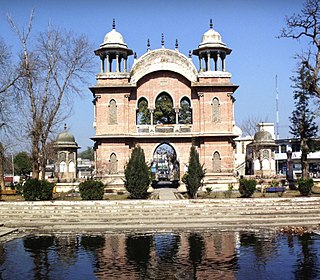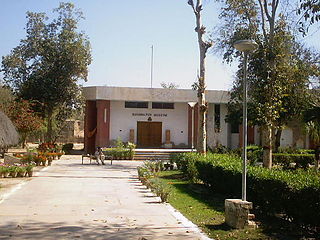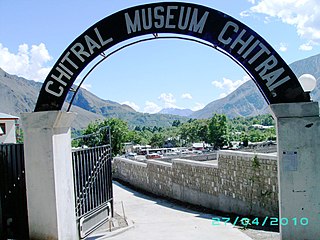
Khyber Pakhtunkhwa, often abbreviated as KPK or KP, is a province of Pakistan. It is located in the northwestern region of the country, along the Pakistan-Afghanistan border and close to Tajikistan border.

Bannu District is a district in Bannu Division of Khyber Pakhtunkhwa province in Pakistan. It was recorded as a district in 1861 during the British Raj. It is one of 26 districts that make up the Khyber Pakhtunkhwa province of Pakistan. It borders North Waziristan to the northwest, Karak to the northeast, Lakki Marwat and Bettani to the southeast, and South Waziristan to the southwest. It is represented in the provincial assembly by four MPAs.

Mardān is a city in the Mardan District of Khyber Pakhtunkhwa Province, Pakistan. Located in the Valley of Peshawar, Mardan is the second-largest city of Khyber Pakhtunkhwa. It is a fast-growing city that experienced a population boom in the latter half of the twentieth century.

Lakki Marwat or Lakki is the headquarters of Lakki Marwat District in Khyber Pakhtunkhwa province of Pakistan. Lakki Marwat has become one of the fastest growing cities in Khyber Pakhtunkhwa.Lakki Marwat is also the 20th most populous city in the province of Khyber Pakhtunkhwa.

Zhob, formerly known as Appozai or Fort Sandeman, is a city and district capital of Zhob District in Balochistan province of Pakistan. Zhob is located on the banks of Zhob River 337 km from Quetta, the capital of Balochistan.

Bannu is a city located on the Kurram River in southern Khyber Pakhtunkhwa, Pakistan. It is the capital of Bannu Division. Bannu's residents are primarily members of the Banuchi tribe and speak a dialect of Pashto which is similar to the distinct Waziristani dialect.

The Peshawar Museum is a museum located in Peshawar, capital of Pakistan's Khyber Pakhtunkhwa province. The Peshawar Museum is notable for its collection of Buddhist artwork dating from the ancient Gandhara region.

Sattagydia was one of the easternmost regions of the Achaemenid Empire, part of its Seventh tax district according to Herodotus, along with Gandārae, Dadicae and Aparytae. It was situated east of the Sulaiman Mountains up to the Indus River in the basin around Bannu in modern day's southern Khyber Pakhtunkhwa, Pakistan.

Dera Ismail Khan Division is an administrative division of Khyber Pakhtunkhwa Province, Pakistan. It is the southernmost division of Khyber Pakhtunkhwa.
The Tarakai or Taraki is a Khilji Pashtun tribe; mainly found in the Ghazni province of Afghanistan, and they are also living in Quetta, and Kuchlak, Pakistan. They are divided into several major clans/tribes: NawrozKhel, NaKhel, JamalKhel, HarunKhel, MalangKhel, AkhtarKhel, DaryaKhel, MullaKhel, Lilizai, Mul, Gurbuz, Badin, Saki, and MurekKhel. These tribes are further divided into more sub-tribes within the above mentioned clans/tribes.
Sheri Khan Tarakai is an ancient settlement site located in the Bannu District of Khyber-Pakhtunkhwa province, Pakistan. It was occupied from approximately 5000 BC to 2500 BC.

The Bahawalpur Museum, established in 1976, is a museum of archaeology, art, heritage, modern history and religion located in Bahawalpur, Punjab, Pakistan. It comes under the control of Bahawalpur district government.

Pakistan is home to many archaeological sites dating from Lower Paleolithic period to Mughal empire. The earliest known archaeological findings belong to the Soanian culture from the Soan Valley, near modern-day Islamabad. Soan Valley culture is considered as the best known Palaeolithic culture of Central Asia. Mehrgarh in Balochistan is one of the most important Neolithic sites dating from 7000 BCE to 2000 BCE. The Mehrgarh culture was amongst the first culture in the world to establish agriculture and livestock and live in villages. Mehrgarh civilization lasted for 5000 years till 2000 BCE after which people migrated to other areas, possibly Harappa and Mohenjo-daro. Harappa and Mohenjo-daro are the best known sites from the Indus Valley civilization.

Bannu Medical College (BMC) is a public medical institute located in Bannu, Pakistan. It is one of several medical colleges affiliated with the Khyber Medical University and enrolls 100 students each year. BMC is recognized by the Pakistan Medical and Dental Council and is listed in the World Directory of Medical Colleges.

Akra (آکرہ) is an archaeological site in Bannu, Khyber Pakhtunkhwa, Pakistan. It dates from the Early Historic Period.
Dir Museum, also known as Chakdara Museum, is located in Chakdara, Lower Dir District, in the Khyber Pakhtunkhwa province of Pakistan. The museum offers a fine and unique collection of Gandharan Art.
Mardan Museum is located in the Mardan District, Khyber Pakhtunkhwa, Pakistan. The museum was first established in 1991 in a Town Hall with a single hall with 22 show cases displaying more than 90 Gandhara's sculptures by the supervision of Sahibzada Riaz Noor. Later in 2006 a portion of land provided by the Mardan District Government on the request of Provincial Government and build three Galleries which was inaugurated by a former Chief Minister of Khyber Pakhtunkhwa Ameer Haider Khan Hoti in 2009.

Chitral Museum is a museum located in Chitral District, Khyber Pakhtunkhwa, Pakistan, established on 8 July 2010.
City Museum was established on an archaeological site of Gorkhatri, Peshawar, Khyber Pakhtunkhwa, Pakistan. The museum was inaugurated on 23 March 2006 by Akram Khan Durrani the Chief Minister of Khyber Pakhtunkhwa. The museum consists of three galleries: archaeological, ethnological, and antiquities. The latter is the most recent addition, for the exhibition of the antiquities of the British time which provides detailed information about archaeological and ethnological profile of Peshawar.













